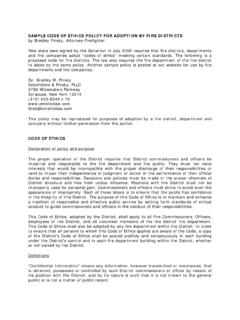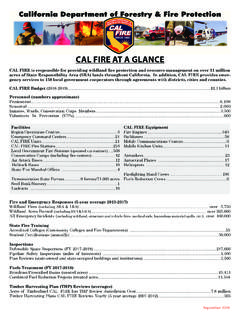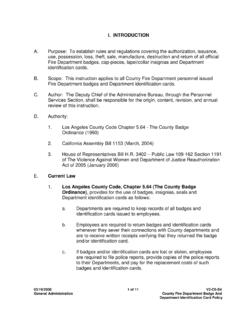Transcription of WATER DISTRIBUTION SYSTEM DESIGN GUIDELINES …
1 WATER SYSTEM DESIGN CRITERIA 02664-1 Rev. 09/2018 WATER DISTRIBUTION SYSTEM DESIGN GUIDELINES part 1 GENERAL GENERAL GUIDELINES A. The following WATER SYSTEM DESIGN GUIDELINES are based on Federal, State and local health requirements and Berkeley County WATER & Sanitation engineering DESIGN criteria. B. DESIGN criteria not indicated herein shall comply with Ten States Standards where applicable. C. All installations are to meet the bacteriological and chemical quality standards of the South Carolina Department of Health and Environmental Control (SCDHEC). D. No line extension shall be made from an existing line when the existing line does not meet the minimum pressure and flow requirements outlined in this section. E. WATER services and plumbing must conform to relevant local plumbing codes or the National Plumbing Code. F. Individual home booster pumps are not allowed to meet the 25 psi minimum pressure at the service connection.
2 G. These DESIGN GUIDELINES are applicable to all developments including but not limited to residential, commercial and industrial developments, subdivisions, and/or parks requiring WATER service from BCWS. SYSTEM DESIGN CRITERIA A. DISTRIBUTION main size: minimum 4" diameter unless otherwise approved by BCWS. WATER mains providing fire service shall be a minimum of 6" unless otherwise approved by BCWS. Larger size mains shall be required if necessary to allow the withdrawal of the required fire flow while maintaining the minimum required residual pressure. WATER mains not designed for fire flows of 500 gpm shall not have hydrants. B. When a variance to the minimum WATER main diameter of 4 inches is approved, small dead end lines shall not exceed the following lengths: 1. 1-inch diameter: 150 feet 2. 1 -inch diameter: 200 feet 3. 1 -inch diameter: 300 feet 4.
3 2-inch diameter: 1,500 feet WATER SYSTEM DESIGN CRITERIA 02664-2 Rev. 09/2018 C. Comply with all application requirements of Federal, State, and local regulations. D. Hazen and Williams DESIGN coefficient: 1. Ductile iron pipe: C = 120 2. PVC pipe: C = 140 E. When a DESIGN is being considered for a project, a main depth of between 3'-5' below finish grade will be used to establish main and branch line profiles. F. Where standard four to six inch diameter hydrants are proposed, the DESIGN flow shall not be less than 500 gpm over and above peak hourly flow. Standard hydrants shall not be placed on systems using only hydro pneumatic storage, unless standby power is provided and the pumping capacity from wells or ground storage exceeds the fire flow demand with the largest well or pump out of service. Standard hydrants shall not be connected to lines not designed to carry fire flows.
4 BCWS MASTER PLAN A. DESIGN SYSTEM to comply and be compatible with BCWS WATER SYSTEM Master Plan. SIZING OF LINES A. Size pipe 6" and larger based on the following criteria: (1) SYSTEM pressures at maximum instantaneous demand (not less than twenty-five (25) pounds per square inch); or (2) fire flow in addition to peak hourly flow (not less than twenty (20) pounds per square inch) or (3) flushing flow in addition to peak hourly flow (not less than twenty (20) pounds per square inch), whichever is the worst case. Peak hourly demand shall be calculated by multiplying BCWS peak hour demand factor of by the average daily WATER usage (225 gpd/res. unit). When fire protection is to be provided, SYSTEM DESIGN should be such that fire flows and facilities are in accordance with the requirements of BCWS and the state Insurance Service Office (ISO). Minimum fire flow shall be 500 gpm with a minimum residual pressure of 20 psi.
5 B. Pipe size 4" and smaller: Size piping based on either maximum instantaneous demand or peak hour plus flushing flow, whichever is greater. C. The maximum instantaneous demand is to be calculated using the Community WATER SYSTEM Source Book by Joseph S. Amen, as reference. WATER SYSTEM DESIGN CRITERIA 02664-3 Rev. 09/2018 Table 1 - Maximum Instantaneous Flows for Residential Areas Number of Residences Served Flow per Residence in GPM 1 (First) 2 10* 11 20** 21 - 30 31 - 40 41 - 50 51 - 60 61 - 70 71 - 80 81 - 90 91 - 100 101 - 125 126 - 150 151 - 175 176 - 200 201 - 300 301 - 400 401 - 500 501 - 750 751 - 1,000 *Second, third, etc., through tenth residence served. **Eleventh, twelfth, etc., through twentieth residence served. Table 2 Maximum Instantaneous Flows for Commercial Areas Type of Business GPM on Basis Shown Barber Shop gpm per chair Beauty Shop gpm per chair Dentist Office gpm per chair Department Store* gpm per employee Drug Store gpm With Fountain Service add gpm per fountain area Serving Meals add gpm per seat Industrial Plants** gpm plus gpm per employee Laundry gpm per 1,000 pounds clothes Launderette gpm per unit Meat Market, Super Market gpm per 2,500 sq.
6 Ft. floor area Motel, Hotel gpm per unit Office Building gpm per 100 sq. ft. floor area or gpm per employee Physicians Office gpm per examining room Restaurant gpm per seat Single Service to gpm total Drive-in to gpm total WATER SYSTEM DESIGN CRITERIA 02664-4 Rev. 09/2018 Service Station gpm per wash rack Theater gpm per seat Drive-in gpm per car space Other Establishments** Estimate at gpm each *Including customer service. **Not including process WATER **Non- WATER using establishments Table 3 Maximum Instantaneous Flows for Institutions Type of Institution Basis of Flow, GPM Boarding Schools, Colleges gpm per student Churches gpm per member Clubs: Country, Civic gpm per member Hospitals gpm per bed Nursing Homes gpm per bed Prisons gpm per inmate Rooming Houses Same as Residential* Schools: Day, Elementary, Junior, Senior High Number of Students GPM Per Student 0 - 50 100 200 300 400 500 600 700 800 900 1,000 1,200 1,400 1,600 1,800 2,000 *Each unit of an apartment building should be considered as an individual residence.
7 D. DESIGN for flushing velocity per SCDHEC regulations. E. All WATER mains, including those not designed to provide fire protection, shall be sized using a hydraulic analysis based on flow demands and pressure requirements. The minimum pressure in all public WATER mains under conditions of maximum instantaneous demand shall be twenty-five WATER SYSTEM DESIGN CRITERIA 02664-5 Rev. 09/2018 (25) pounds per square inch at every customer s tap. Twenty (20) pounds per square inch will be acceptable at any tap when fire flows are provided in excess of maximum peak hourly flow [ (D)(4)(a)]. The normal working pressure in the DISTRIBUTION SYSTEM should be approximately 50 80 psi and not less than 30 psi. F. The Developer s DESIGN Engineer is to determine available static and residual pressures at the delivery point for the WATER to a new development. The data is to be obtained under the direction of an engineer who is registered in the State of South Carolina.
8 G. Flow test results, conducted in the past 12 months, are required at a location near the proposed connection to the existing SYSTEM . The results should include: static pressure and residual pressure at a known flow, time and date of test, existing pipe size, type of pipe, and the elevation and distance between the test point and connection. The known flow must be in excess of the demand for the extension. VALVES A. Provide three (3) valves for a tee intersection. B. Sufficient valves shall be provided on WATER mains so that inconvenience and sanitary hazards will be minimized during repairs. Valves should be located at not more than 1000 foot intervals in commercial districts and at not more than one block or 2000 foot intervals in other districts. Valves should be placed to minimize the number of BCWS customers out of service due to a main break and/or any maintenance operation.
9 BCWS reserves the right to require additional valves if it is deemed in the best interest of current and future BCWS customers. INDUSTRIAL OR SPECIAL DESIGN CONDITIONS A. DESIGN of WATER systems for industrial or other systems not covered under this section shall be approved on a special case basis only. Special requests need to be made to BCWS. DEAD ENDS A. Minimize dead ends by looping of all mains. B. Where dead ends occur provide a fire hydrant on lines 6" and larger and a blow off on lines 4" in diameter and smaller. BCWS permits installation of post hydrants for the purposes of flushing so long as the line is capable of providing a flow of 250 gpm. Flushing devices should be sized to provide WATER SYSTEM DESIGN CRITERIA 02664-6 Rev. 09/2018 flows which will give a velocity of at least feet per second in the WATER main being flushed. C. Do not connect any flushing device to any sanitary sewer. SEPARATION OF WATER MAINS AND SEWERS A.
10 Where possible, locate WATER line at least ten (10) feet away, horizontally, from sewer pipes. The distance shall be measured edge to edge. B. Should ten (10) foot separation not be practical, then the WATER main may be located closer provided: 1. It is laid in a separate trench. 2. It is laid in the same trench with the sewer main located at one side on a bench of undistributed earth. 3. In either of the above cases, crown elevation of the sewer shall be at least 18" below invert elevation of WATER line. C. Where WATER lines cross over sewers, maintain 18" minimum vertical distance between the outside of the WATER main and the outside of the sewer. This shall be the case where the WATER main is either above or below the sewer. At crossings, one full length of WATER pipe shall be located so both joints will be as far from the sewer as possible. Mechanical joints will be used for the transition in the sewer line.






![SUBCHAPTER 4 [404.0] Art. 5 Limitations Outside the ...](/cache/preview/2/2/1/6/8/f/b/d/thumb-22168fbde62f17279b7fd12d0f3aed03.jpg)